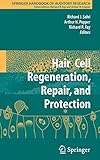Hair Cell Regeneration, Repair, and Protection / edited by Richard J. Salvi, Arthur N. Popper, Richard R. Fay.
Tipo de material: TextoSeries Springer Handbook of Auditory Research ; 33Editor: New York, NY : Springer New York, 2008Descripción: recurso en líneaTipo de contenido:
TextoSeries Springer Handbook of Auditory Research ; 33Editor: New York, NY : Springer New York, 2008Descripción: recurso en líneaTipo de contenido: - texto
- computadora
- recurso en línea
- 9780387733647
- QP351-495
Springer eBooks
Overview: Regeneration and Repair -- Morphological Correlates of Regeneration and Repair in the Inner Ear -- Recovery of Function in the Avian Auditory System After Ototrauma -- Functional Recovery After Hair Cell Regeneration in Birds -- Hair Cell Regeneration: Mechanisms Guiding Cellular Proliferation and Differentiation -- Protection and Repair of Inner Ear Sensory Cells -- Gene Arrays, Cell Lines, Stem Cells, and Sensory Regeneration in Mammalian Ears.
The sensory hair cells in the inner ear and vestibular system convert mechanical stimuli, sound and motion into neural activity that is responsible for the sensations of hearing, motion and head position. In mammals, the loss of hair cells from acoustic overstimulation, ototoxic drugs and aging is irreversible, leading to a permanent loss of function. However, it is now clear that hair cells in other vertebrates are capable of regenerating and recovering partial or complete function. Moreover, partially damaged hair cells can undergo self-repair or be protected from traumatic insults by external compounds. Hair Cell Regeneration, Repair, and Protection provides a comprehensive survey of what is currently known about the regeneration, repair and protection of sensory hair cells and subsequent recovery of function in the auditory and vestibular system. The aim is to provide graduate students, postdoctoral fellows, clinicians and scientists in related disciplines with the biological bases of hair cells and with an understanding of the factors that contribute to their regeneration and repair. Table of Contents: Overview: Regeneration and repair Richard J. Salvi Morphological Correlates of Regeneration and Repair in the Inner Ear Jason R. Meyers and Jeffrey T. Corwin The recovery of function in the avian auditory system following ototrauma James C. Saunders and Richard J. Salvi Functional recovery following hair cell regeneration in birds Robert J. Dooling, Micheal L. Dent, Amanda M. Lauer, and Brenda M. Ryals Hair cell regeneration: Mechanisms guiding cellular proliferation and differentiation Elizabeth C. Oesterle and Jennifer S. Stone Protection and repair of inner ear sensory cells Andrew Forge and Thomas R. Van De Water Gene arrays, cell lines, stem cells, and sensory regeneration in mammalian ears Marcelo N. Rivolta and Matthew C. Holley About the editors: Richard J. Salvi, Center for Hearing and Deafness, University of Buffalo, NY. Arthur N. Popper is Professor in the Department of Biology and Co-Director of the Center for Comparative and Evolutionary Biology of Hearing at the University of Maryland, College Park. Richard R. Fay is Director of the Parmly Hearing Institute and Professor of Psychology at Loyola University of Chicago.
Para consulta fuera de la UANL se requiere clave de acceso remoto.


